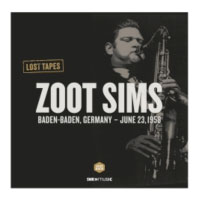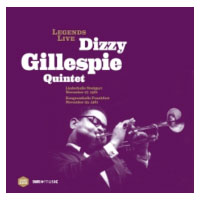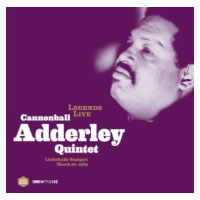This latest installment of VIP concerns what I believe to be an important new source of live concert recordings of great jazz musicians of the 20th century. The European concert house offered a level of freedom and adventure not enjoyed on most US stages, and certainly not in recording sessions for most of the major US labels. All three of these records have well recorded vital music, played in front of sympathetic European audiences. All three of these records come with fee digital downloads, so you can take them with you when you leave the house.
The Jazzhaus story, from their website:
“Jazzhaus is a new music label featuring an indefinite number of audio and video jazz programs taken from live radio and television recordings from the archives of Südwestrundfunk Stuttgart, Baden-Baden and Mainz in south west Germany.
Jazz broadcasts by Südwestrundfunk (SWR) started in the summer of 1947 with young impresarios Joachim Ernst Berendt and Dieter Zimmerle. Today, almost 65 years later, the archives contain about 1,600 audio and more than 350 television recordings of all major modern jazz artists – probably the biggest collection of unpublished live jazz recordings in the world: 3,000 hours – and almost all of it has never been released before. More than 400 ensembles and soloists are listed – many of them recorded three, four, five or more times over the decades.
For the last three years, the jazzhaus team has been thoroughly researching the vaults, carefully making the final selections. The old tapes are currently being remastered to high-end technology standards and will be released on CD, DVD, vinyl and as audio /video-on-demand downloads.”
Zoot Sims, Baden-Baden June 23, 1958
Hans Koller-Tenor Sax and Clarinet
Adi Feuerstein-Flute
Gerd Husemann-Flute
Willie Dennis-Trombone
Helmut Brandt-Bari Sax
Hans Hammerschmid-Piano
Peter Trunk-Bass
Kenny Clarke-Drums
“All the Things You Are” is a great song for tuning up, getting the ensemble playing together and adjust tuning. Like athletes, musicians need a few plays to get on the same page. The Jerome Kern standard is very melodic and swings in the traditional pre-bop notion of swing, a little more than the stereotypical “cool school” performance.
“Minor Meeting for Two Clarinets”, by pianist Hans Hammerschmid, is required listening for connoisseurs of the clarinet. This charming tune uses the full range of the clarinet, including the low, or Chalumeau register, under-represented in jazz. Hammerschmid’s piano and Peter Trunk’s bass solos are somewhat “hard bop” compared to the “cool school” sound of Sims and Koller, though they always fall in line as accompanists, just as it should always be. This charming tune is a big enough reason to own this set.
“Blue Night”, also by Hammerschmid, features the addition of the two flutes, trombone and bari sax. This large group tune has hints of Mancini, like the theme song for a detective show, but with a touch of Ellington, too. Who’s to complain if something sounds like Mancini and Ellington? Not me! There’s also a touch of bombast, a la Kenton. There’s another fine piano solo.
“Open Door”, again by Hammerschimd, swings brightly with two flutes and two altos, reminding me of a latter day European “Herman’s Herd”. “Fallin’ In Love”, by Richard Rogers is brisk and never lacks for forward momentum.
“I Surrender Dear”, by Harry Barris, features an amazing bari sax solo by Helmut Brandt. His solo style, somewhat reminiscent of Mulligan, though Brandt pushes the instrument further to its upper limits than any other bari sax player I could remember. Playing at the top of the bari sax’s range is exposed and precarious. Much like entering a delivery truck at the 24 hours of Le Mans, it takes a brave soul. The tune itself is warm and melancholy.
“Tangerine”, by Victor Schertzinger, is a perfect fit for Sims. Laid back, easy going and snappy, it plays to his strengths, or vice-versa.
The sound is big mono; warm and pretty. Audience sound is non-intrusive and when they clap, it doesn’t sound like white noise, but actual palms hitting. Instrumental timbre is excellent; tonal balance is forgiving and full bodied. Dynamics are snappy and dynamic. The vinyl was almost perfect.
If you are a fan of The Cool School, you’ll find plenty to enjoy. The medium size ensemble featured on four tracks adds harmonic and textural variety, and the “bop” solos of the pianist and bassist adds stylistic variety that breaks up what could become monotonous, a criticism I have of some “cool” jazz ensembles. An important recording for many reasons, and recommended.
Dizzy Gillespie Quintet
Liederhalle Stuttgart November 27, 1961
Kongresshalle Frankfurt November 29, 1961
Leo Wright-Alto Sax, Flute
Lalo Schifrin-Piano
Bob Cunningham-Bass
Mel Lewis-Drums
A live recording of Dizzy playing Ellington’s “The Mooche”, of Dizzy the court jester and Dizzy the serious, of the under-appreciated Lalo Schifrin and Leo Wright, makes this an intriguing concert. The 16’05” recording of “The Mooche” is suave and sophisticated, just like its composer, the incomparable Duke Ellington. Much like an Ellington arrangement, Dizzy’s version has plenty of open space to accentuate the hot and cool moments, and keep you on your toes. Dizzy is explosively dynamic and fiery here, as very few could play, and you can here him “light up the room”—the sound of his trumpet hitting the back wall and returning to the microphones. Schifrin’s solo stretches Ellington’s tonality to near avant-garde levels, and he flashes a prodigious talent in lines that seem to be influenced by both hard bop and stride, as strange as that might sound; but it sounds brilliant.
“Willow Weep For Me”, by Ann Ronell, a world class flute solo by Leo Wright, with bright and breezy chords underpinning by Schifrin, takes on a funky feel with a slightly jarring transition.
“Kush”, by Dizzy Gillespie, is another marathon tune, this time featuring the muted trumpet of Dizzy. His interplay with Bassist Cunningham and drummer Lewis, without the benefit of piano accompaniment, is another exercise in space and lines, becoming almost architectural in size and shape.
In the vein of “Salt Peanuts”, “Oops-Shoo-Be-Doo-Be”, also by Gillespie, is Dizzy the showman, the court jester, the ham, injecting a humorous tune to lighten the mood, and expertly placed to break up any monotony that might otherwise occur. For many in the audience, this is the Dizzy they wanted to see, with scat singing and another fiery solo. It’s enjoyable. There was a time when black musicians were castigated unfairly, by other black musicians, for playing ‘crowd pleasers’. Regardless of your race, religion or political affiliation, giving the customer what they want never went out of style: they paid for their tickets. As a musician, you are there to please the paying customers. That’s how it is. When you pay for gasoline, you don’t want diesel. If you want to play obscure avant-garde atonal serialism, by all means find a bunch of music students, who may pretend to understand and enjoy, but don’t force it on the public and expect them to be receptive. Dizzy was a pragmatic man, and knew that for jazz to keep paying customers, a certain amount of pandering was in order. It’s brilliant pandering though!
“I Can’t Get Started”, by Vernon Duke, humorously begins very slowly. Get it? I can’t get started? Dizzy puts on a clinic, demonstrating long lines, power, extended range, musical quotes, with an ease that very few musicians in the history of jazz could display. Dizzy Gillespie belongs on a pedestal, with the likes of Louis Armstrong, John Coltrane and Duke Ellington—absolute masters of a difficult art!
The sound varies somewhat on this album, seeing as it was recorded in two different places. I believe all the tracks are mono, but full-sized mono. The sound on “Kush” is a little dry, and the muted trumpet played hell on my system with the Audio Techinca micro line stylus. It did sound much smoother after switching to elliptical. I imagine that his mute was causing some distortion in the original recording chain. The rest of the tracks were warmer, with powerful dynamics. The vinyl was perfect—no noise.
Cannonball Adderley Quintet
Liederhalle Stuttgart March 20, 1969
Nat Adderley-Cornet
Joe Zawinul-Keyboards
Victor Gaskin-Bass
Roy McCurdy-Drums
I’m saving the best for last. This live set is essential for Adderley fans. If you like anything you’ve heard with Cannonball, there is a greater than zero chance you will enjoy this record. Julian “Cannonball” Adderley was one of the more tasteful jazz musicians, with a style that straddled hard bop and soul jazz, played with fluidity that few could match, giving his playing an almost cool sound. His playing is inimitable. It reminds me of Mozart. It sounds “easy”, just like a great athlete makes it look easy.
“Rumpelstiltskin”, by Zawinul, is hard bop with a touch of soul. From the very beginning of the tune, it made apparent that Adderley’s time at Capitol was mostly a waste of his, and ours. The playing and sound on this track easily beats the majority of his output on Crapitall, I mean Capitol. By 1969, jazz was barely hanging on commercially, and these live recordings are a window onto what could have been. Infused with a touch of free-form and angularity, and a Come-To-Jesus prayer meeting, it’s not the same Zawinul we hear in Weather Report. It sounds as if it were written with Adderley, or expressly for him.
“Sweet Emma”, by Nat Adderley, is soul-jazz, a Southern concoction the equivalent of cornbread, black-eyed peas seasoned with salt-pork bacon, rice and sweet ice tea. I’m sure there are those who hate this style of jazz, but for me it’s like putting on a favorite pair of jeans. There’s nothing pretentious about this music, something that is the bedrock of a good many of Miles Davis’s later recordings. This is honest and pure in spirit. It’s more laid back than other soul-jazz offerings, sounding as if it were conceived in the shade during a hot august afternoon. Nat’s solo is strong. Zawinul’s accompaniment is inspired and funky.
On “Oh Babe”, also by Nat Adderley, Zawinul plays a funky blue electric piano with a “square” angular style that seems to make it even funkier. “Why Am I Treated So Bad”, by Roebuck “Pops” Staples, is a stripped down version, full of pathos and soul, of the Staple Singers original. There is another great solo for Zawinul.
“The Painted Dessert”, by Zawinul, straddles both hard bop and avant-garde, and stands out for its bravery. Finishing out the set, “Work Song” the smash hit by Nat Adderley, is a crowd favorite, and still holds up all these years later.
The sound is mostly excellent on this record. It’s stereo, mixed from a combination of instrument mics and mics to catch both the ensemble sound and hall ambience. There are some tape drop-outs, but nothing serious. For the most part, it borders on audiophile quality, with natural warmth and good space. This one I recommend to all jazz and funk fans.
All these recordings have spontaneity due in part to the European audience, and in some cases unknown musicians. I encourage you to visit www.jazzhaus-label.com and view what I hope will become a significant source of new-old recordings by important jazz musicians.
- (Page 1 of 1)




Philip thanks for the reviews, can’t wait to get these.
jack
Thanks! These are great performances.
Phillip,
Are these available in the US anywhere? Naxos is listed as their distributor but there’s nothing on the Naxos site about them.
Beau,
I’m not sure. It’s such a new line that most, if not all, of the normal “audiophile” record sellers won’t even know about it. Try Amazon. I regularly buy vinyl off Amazon.
Thanks,
Phillip
Phillip,
Thanks, I had looked at all the “normal” sources and I didn’t even remember to check with Amazon. Found them with an Amazon associate.
Beau
Phillip,
These are definitely worth searching out. Nice packaging and quiet vinyl and most important a great window on the past.
Thanks for the recommendation and here’s hoping that they come out with more performances soon.
Beau,
I’m glad you enjoyed them. I hope they sell well enough to encourage future releases.
Cheers,
Phillip